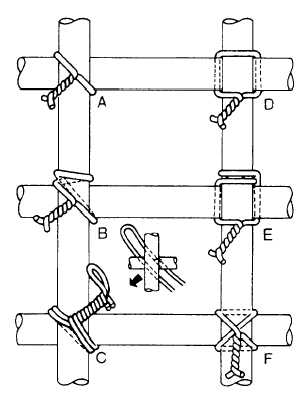Failure to inspect form work during and after concrete placement to detect abnormal deflections or other signs of imminent failure.
There are many reasons why forms fail. It is the responsibility of the Builder to ensure that the forms are correctly constructed according to design, and that proper techniques are followed.
REINFORCED CONCRETE
LEARNING OBJECTIVE: Upon completing this section, you should be able to determine the types of ties for and placement of reinforcing steel.
Concrete is strong under compression, but relatively weak under tension. The reverse is true for steel. Therefore, when the two are combined, one makes up for the deficiency of the other. When steel is embedded in concrete in a manner that assists it in carrying imposed loads, the combination is known as reinforced concrete. The steel may consist of welded wire fabric or expanded metal mesh, but, more often, it consists of reinforcing bars, or more commonly "rebar."
WELDED WIRE FABRIC
Welded wire fabric, often referred to as "wire mesh," comes in rolls and sheets. These must be cut to tit your individual application. The individual sections of fabric must be tied together, or "lapped," to form a continuous sheet of fabric.
Specifications and designs are usually used when wire fabric is being lapped. However, as a rule of thumb, one complete lap is usually sufficient with a minimum of 2 inches between laps. Whenever the rule of thumb is not allowed, use the end lap or side lap method.
In the end lap method, the wire mesh is lapped by overlapping one full mesh measured from the end of the longitudinal wires in one piece to the end of longitudinal wires in the adjacent piece. The two pieces are then tied at 1 1/2-foot centers with a snap tie. In the side lap method, the two longitudinal side wires are placed one alongside and overlapping the other and then are tied with a snap tie every 3 feet.
REINFORCING STEEL
Before placing reinforcing steel in forms, all form oiling should be completed. As mentioned earlier, oil or other coating should not contact the reinforcing steel in the formwork. Oil on reinforcing bars reduces the bond between the bars and the concrete. Use a piece of burlap to clean the bars of rust, scale, grease, mud, or other foreign matter. A light film of rust or mill scale is not objectionable.
Rebars must be tied together for the bars to remain in a desired arrangement during pouring. Tying is also a means of keeping laps or splices in place. Laps allow bond stress to transfer the load from one bar, first into the concrete and then into the second bar.
Methods of Tying
Several types of ties can be used with rebar. Some are more effective than others. The views in figure 7-20 illustrate the six types used by the Seabees: (A) snap, or simple, tie, (B) wall tie, (C) double-strand tie, (D) saddle tie, (E) saddle tie with twist, and (F) cross, or figure-eight, tie. As a Builder, you will probably be concerned only with the snap

Figure 7-20.-Types of ties.
Continue Reading